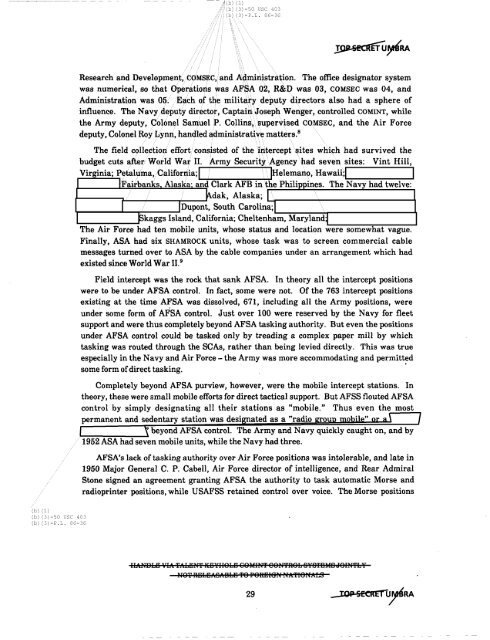American Cryptology during the Cold War - The Black Vault
American Cryptology during the Cold War - The Black Vault
American Cryptology during the Cold War - The Black Vault
Create successful ePaper yourself
Turn your PDF publications into a flip-book with our unique Google optimized e-Paper software.
J!lb) (1)<br />
Ib) (3) -50 USC 403<br />
Ib) (3) -P.L. 86-36<br />
Research and Development,COMSEC, and At:lmirtistration. <strong>The</strong> office designator system<br />
was numerical, so that Operations was AFSA 02., R&D was 03, COMSEC was 04, and<br />
Administration was 05./Each of <strong>the</strong> military deputy directors also had a sphere of<br />
influence. <strong>The</strong> NavYideputy director, Captain. Joseph Wenger, controlled COMINT, while<br />
<strong>the</strong> Army deputy, Colonel Sam:ueIP. Collins,\supervised COMSEC, and <strong>the</strong> Air Force<br />
deputy, Colonel Roy Lynn, handled administrative matters. s<br />
<strong>The</strong> field collection effort consisted of <strong>the</strong> iriterceptsites which had survived <strong>the</strong><br />
budget cuts after/Wo.rld <strong>War</strong> II. Army SecuritY\Agencyhad seven sites: Vint Hill,<br />
Virginia; Petaluma,/California;1 lHelemano, Hawaii;1 I<br />
Fairbanks Alaska' and Clark AFB in <strong>the</strong> Philippines. <strong>The</strong> Navy had twelve:<br />
1r- ......._,.....__---JDupont. ~:~hA~....r:~!na~\· \. \<br />
L- .rkaggs Island, California; Cheltenham, Maryland;1<br />
<strong>The</strong> Air Force had ten mobile units, whose status and location were somewhat vague.<br />
Finally, ASA had six SHAMROCK units, whose task was to screen commercial cable<br />
messages turned over to ASA by <strong>the</strong> cable companies under an arrangement which had<br />
existed since World <strong>War</strong> 11. 9<br />
Field intercept was <strong>the</strong> rock that sank AFSA. In <strong>the</strong>ory all <strong>the</strong> intercept positions<br />
were to be under AFSA control. In fact, some were not. Of <strong>the</strong> 763 intercept positions<br />
existing at <strong>the</strong> time AFSA was dissolved, 671, including all <strong>the</strong> Army positions, were<br />
under some form of AFSA control. Just over 100 were reserved by <strong>the</strong> Navy for fleet<br />
support and were thus completely beyond AFSA tasking authority. But even <strong>the</strong> positions<br />
under AFSA control could be tasked only by treading a complex paper mill by which<br />
tasking was routed through <strong>the</strong> SCAs, ra<strong>the</strong>r than being levied directly. This was true<br />
especially in <strong>the</strong> Navy and Air Force - <strong>the</strong> Army was more accommodating and permitt~d<br />
some form ofdirect tasking.<br />
Completely beyond AFSA purview, however, were <strong>the</strong> mobile intercept stations. In<br />
<strong>the</strong>ory, <strong>the</strong>se were small mobile efforts for direct tactical support. But AFSS flouted AFSA<br />
control by simply designating all <strong>the</strong>ir stations as "mobile." Thus even <strong>the</strong> most<br />
permanent and sedentary station was desi ated as a "radio au mo' "<br />
....._...,...,....,...~-~, beyond AFSA control. <strong>The</strong> Army and Navy quickly caught on, and by<br />
1952 ASA had seven mobile units, while <strong>the</strong> Navy had three.<br />
AFSA's lack of tasking authority over Air Force positions was intolerable, and late in<br />
1950 Major General C. P. Cabell, Air Force director of intelligence, and Rear Admiral<br />
Stone signed an agreement granting AFSA <strong>the</strong> authority to task automatic Morse and<br />
radioprinter positions, while USAFSS retained control over voice. <strong>The</strong> Morse positions<br />
(1)<br />
Ib) (3) -50 USC 403<br />
Ib) (3) -P.L. 86-36<br />
IIMfBbFJ IfII. 'F/.bBN'f KBYIIS15B 8SMHi'f eSN'fRS15 BYB'fBM8dSHi'fc'[<br />
NQ'i' RBf5BASltBbFJ 'f0 FORSIaN' N'A:fIOftAf:S<br />
29
















